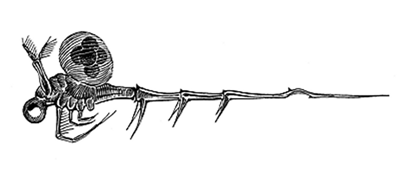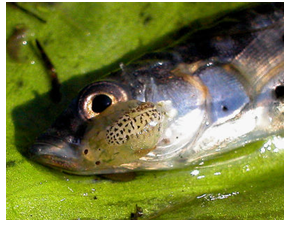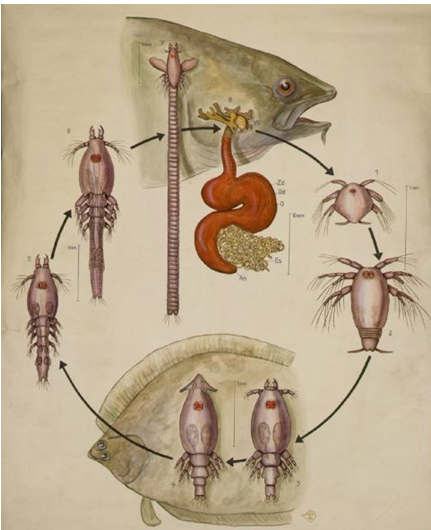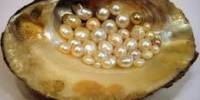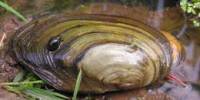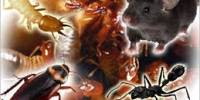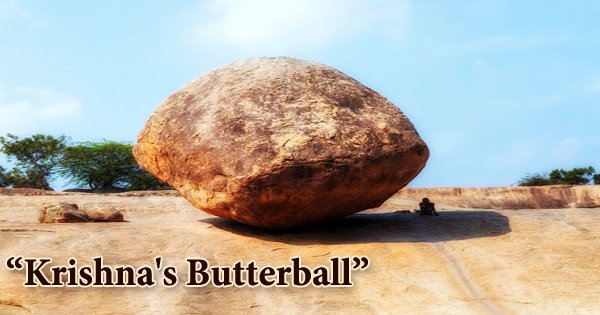Crustacea
Crustaceans (Crustacea) form a very large group of arthropods, usually treated as a class, which includes such familiar animals as crabs, lobsters, crayfish, shrimp, krill and barnacles. The 67,000 described species range in size from Stygotantulus stocki at 0.1 mm (0.004 in), to the Japanese spider crab with a leg span of up to 12.5 ft (3.8 m) and a mass of 44 lb (20 kg). Like other arthropods, crustaceans have an exoskeleton, which they moult to grow. They are distinguished from other groups of arthropods, such as insects, myriapods and chelicerates, by the possession of biramous (two-parted) limbs, and by the nauplius form of the larvae.
Majority are aquatic, living in either fresh or marine environments, but a few group like terrestrial crabs, terrestrial hermit crabs and wood lice are adapted to terrestrial life. Majority are free living but a few are parasitic (e.g. Rhizocephala, fish lice, tongue worms) and sessile (barnacles). Mostly nocturnal.
The group has an extensive fossil record, reaching back to the Cambrian, and includes living fossils such as Triops cancriformis, which has existed apparently unchanged since the Triassic period. More than 10 million tons of crustaceans are produced by fishery or farming for human consumption, the majority of it being shrimps and prawns. Krill and copepods are not as widely fished, but may be the animals with the greatest biomass on the planet, and form a vital part of the food chain.
So far 185 crustacean species under 89 genera and 45 families have been described from in Bangladesh and still there are specimens to identify up to species level.
General Description
The body of a crustacean is composed of body segments, which are grouped into three regions: the cephalon or head, the thorax, and the pleon or abdomen. The head and thorax may be fused together to form a cephalothorax, which may be covered by a single large carapace. The crustacean body is protected by the hard exoskeleton, which must be moulted for the animal to grow. The shell around each somite can be divided into a dorsal tergum, ventral sternum and a lateral pleuron. Various parts of the exoskeleton may be fused together.
Each somite, or body segment can bear a pair of appendages: on the segments of the head, these include two pairs of antennae, the mandibles and maxillae; the thoracic segments bear legs, which may be specialized as pereiopods (walking legs) and maxillipeds (feeding legs). The abdomen bears pleopods, and ends in a telson, which bears the anus, and is often flanked by uropods to form a tail fan. The number and variety of appendages in different crustaceans may be partly responsible for the group’s success. Crustacean appendages are typically biramous, meaning they are divided into two parts; this includes the second pair of antennae, but not the first, which is uniramous. It is unclear whether the biramous condition is a derived state which evolved in crustaceans, or whether the second branch of the limb has been lost in all other groups. Trilobites, for instance, also possessed biramous appendages.
The main body cavity is an open circulatory system, where blood is pumped into the haemocoel by a heart located near the dorsum. Malacostraca have haemocyanin as the oxygen-carrying pigment, while copepods, ostracods, barnacles and branchiopods have haemoglobins. The alimentary canal consists of a straight tube that often has a gizzard-like “gastric mill” for grinding food and a pair of digestive glands that absorb food; this structure goes in a spiral format. Structures that function as kidneys are located near the antennae. A brain exists in the form of ganglia close to the antennae, and a collection of major ganglia is found below the gut.
In many decapods, the first (and sometimes the second) pair of pleopods are specialised in the male for sperm transfer. Many terrestrial crustaceans (such as the Christmas Island red crab) mate seasonally and return to the sea to release the eggs. Others, such as woodlice, lay their eggs on land, albeit in damp conditions. In most decapods, the females retain the eggs until they hatch into free-swimming larvae.
Economic importance
Crustaceans are of great economic importance to humans. The group is of great value directly or indirectly for his health and economic progress.
The larger crustaceans-shrimps, crabs and lobsters are consumed by humans, throughout the world. Bangladesh earns around $ 363 million per year by exporting these shellfishes. Globally nearly 10milion tons were produced in 2005 (FAO, 2007).
Small zooplanktonic crustaceans, such as copepods, water fleas and krill are a major link in the food chain between the photosynthetic phytoplankton and the larger carnivores such as fish and whales.
Tiny crustaceans (zooplanktons) are staple food for fishes and many vertebrates eat insects and spiders.
Aesthetic Value
Beauty and uniqueness of crustaceans are of great aesthetic appealing to human of all ages. Crustaceans of varieties of sizes, shapes, forms, colors are astounding creations of nature. Several crustaceans such as spider crab,ghost crab, fiddler crab (Ocypodidae), moon crab (Matutidae), rock crab, lightfooted crab, paddler crab (Graspidae), arrow crab, , pebble crab (Leusiidae), box crab (Calappidae), coconut crab, hermit crab, fairy shrimp, cherry shrimp, ghost shrimp, bamboo shrimp, banana shrimp, freshwater crayfish, blue crayfish, tiger crayfish, blue lobster, mantis shrimp etc are very curiosity stimulating creatures. So, these crabs, shrimps, crayfishes takes a major place in hobby world. They are also a great attraction in all public aquariums.
Some most popular species are Freshwater Atyid shrimps of genus Triops, Palaemonetes and Caridina, Atyopsis, Neocaridina and crayfishes from genus Procambarus and Cambarellus.
Here is picture of some ornamental shrimps. As described above, all shrimps are from family Atydiae. Amazingly, last two shrimps are native ones. The banana shrimp is abundant in hill streams of Chittagong. Yellow shrimp, along with another beautiful shrimp, Needle-nose caridina (Caridina gracilirostris) are found in local ditches, ponds and other waterbodies.
Commercial Value
For human consumption, the crustaceans that are farmed and harvested belong to class Malacostraca.
Crabs make up to 20% of all marine crustaceans caught, farmed and consumed worldwide, amounting to 1.5 million tons annually. One species Portunus trituberculatus accounts for one fifth of the total.
As lobster are considered a great delicacy all over the world, lobster fishing , sometimes called lobstering is the commercial harvesting of marine lobsters, spiny lobsters or crayfish.
Commercial shrimp farming began in 1070s, production grew sleeply thereafter. About 75% of farmed shrimp and prawn is produced in Asia (particularly in China and Thailand)
Virtually all farmed shrimps are penaeids and just two species of shrimp Pacific white shrimp (Litopenaeus vannamei, formerly Penaeus vannamei) and Giant tiger prawn (Penaeus monodon)
account for about 80% of all farmed shrimp.
All farmed freshwater prawns belongs to genus Macrobrachium. M. rosenbergii, M.nipponense, M.malacolmsonii are major species that are farmed in the industry.
Besides, ornamental shrimps and crayfishes are also farmed in East Asian Ccountries.
Krill has been harvested as a food source for humans and domesticated animals since at least the 19th century, and possibly earlier in Japan.
Commercial fishing of Krill i.e. the common name given to the order Euphausiacea of shrimp-like marine crustaceans. These small invertebrates are found in all oceans of the world. is doen on the Southern Ocean and in the water around the Japan. The total global harvest amounts to15,000 to 20,000 tons (150,000–200,000 long tons; 170,000–220,000 short tons) annually, most of this from the Scotia Sea. Most of the krill catch is used for aquaculture and aquarium feeds, as bait in sport fishing, or in the pharmaceutical industry. In Japan and Russia, krill is also used for human consumption and is known as okiami in Japan.
Branchiopods (fairy shrimp, clam shrimp) and some copepods are commercially cultured, as they are used in fish-farms and also used as aquarium fish-feeds.
Several employment/craft such as stocking, feeding, picking, sorting are built up centering these crustacean farming and harvesting.
Gastronomic Value
Archaeological finds has shown that humans have been making use of shellfish as a food item for hundreds of thousands of years. In the present, shellfish dishes are a feature of almost all the cuisines of the world, providing an important source of protein in many cuisines around the world, especially in the countries with coastal areas.
Actually, shellfish is a culinary and fisheries term for exoskeleton-bearing aquatic invertebrates used as food, including various species of molluscs, crustaceans and sometimes of echinoderms.
So, crustaceans takes a major role in shellfish delicacy. Almost all shellfishes are aquatic and harvested from saltwater, though some kinds are found only in freshwater. In addition a few species of land crabs are eaten, for example Cardisoma guanhumi in the Caribbean.
Many animals feed on krill, ranging from smaller animals like fish or penguins to larger ones like seals and even baleen whales.
Krill are an important element of the aquatic food chain. Krill convert the primary production of their prey into a form suitable for consumption by larger animals that cannot feed directly on the minuscule algae. Northern krill and some other species have a relatively small filtering basket and actively hunt copepods and larger zooplankton.
Well-known species of the Euphausiidae of commercial krill fisheries include Antarctic krill (Euphausia superba), Pacific krill (Euphausia pacifica) and Northern krill (Meganyctiphanes norvegica).
Marine ostracods and copepods are usually the dominant members of the zooplankton and are major food organisms for small fish, whales, sea-birds and othercrustaceans such as Krill in the ocean and freshwater.
Branchiopods (brine shrimp and fairy shrimp) are used as food of fish fry/aquarium fish food.
Biomedical Value
Krill oil works as a dietary supplement ingredient. Two clinical trials have been published; tests included lipid lowering, arthritis pain and function, and C-reactive protein.
Three of the most important nutrients in krill oil are: (1) omega-3 fatty acids similar to those of fish oil, (2) omega-3 fatty acids attached (conjugated) to phospholipids, mainly phosphatidylcholine (alternatively referred to as marine lecithin) and (3) astaxanthin, an antioxidant.
A study conducted by McGill University compared the effects of fish oil and krill oil on cholesterol. Daily doses of 1-3g of krill oil are significantly more effective in the treatment of hyperlipidemia than the same daily dose of fish oil.
Bioindicator
Planktonic copepods are important to global ecology and the carbon cycle. Some scientists say they form the largest animal biomass on earth. Copepods compete for this title with Antarctic krill (Euphausia superba). C. glacialis inhabit the edge of the Arctic icepack, where they alone comprise up to 80% of zooplankton biomass.
Geologiacal Value
Ostracods (seed shrimp) are “by far the most common arthropods in the fossil record” with fossils being found from the Cambrian to the present day. An outline microfaunal zonal scheme based on both Foraminifera and Ostracoda was compiled by M. B. Hart. Freshwater ostracods have even been found in Baltic amber of Eocene age, having presumably been washed onto trees during floods.
So, traditionally and frequently, ostracods are studied in Geology.
Ostracods have been particularly useful for the biozonation of marine strata on a local or regional scale, and they are invaluable indicators of paleo-environments because of their widespread occurrence, small size, easily-preservable generally-moulted calcified bivalve carapaces, the valves are a commonly found microfossil.
Miscellaneous Uses
Live copepods are used in the saltwater aquarium hobby as a food source and are generally considered beneficial in most reef tanks. They are scavengers and also may feed on algae, including coralline algae.
Live copepods are popular among hobbyists who are attempting to keep particularly difficult species such as the mandarin dragonet or scooter blenny. They are also popular to hobbyists who want to breed marine species in captivity. In a saltwater aquarium, copepods are typically stocked in the refugium.
Using crustaceans as bait is a popular tradition. Sand flea or mole crab (Emerita talpoida) is a popular fishing bait used in game-fish hunting in seas.
Woodlice i.e. terrestrial crustaceans with a rigid, segmented, long exoskeleton and fourteen jointed limbs form the suborder Oniscidea within the order Isopoda, with over 3,000 known species, are generally considered beneficial in gardens for their role in producing compost and overturning the soil.
Demerits/ Biodeterioration
As pests
Water fleas (specially spiny water fleas, Bythotrephes & Cercopagis spp.) are considered as pest in fish farms.
Water fleas eat smaller zooplankton that an important food item for juvenile fish. And because of their ability to reproduce quickly, this feature enables them to monopolize the food supply.
Spiny water-flea
Although the water fleas can fall prey to fish, their spine seems to frustrate most small fish, which tend to experience great difficulty swallowing the animal. Studies indicate spiny water fleas adversely affect the growth rates and survival of young fish, due to the competition for food and experts believe the fishhook water flea will have the same effect.
Lake anglers are most likely to encounter water fleas on their fishing lines in clumps of hundreds of individuals. The long spiny tails can become entangled on fishing lines, creating havoc for anglers as the first line guide of their fishing rod becomes clogged. Anglers have reported having to cut their lines because they are unable to reel them in. These masses of individuals look and feel like wet cotton.
Wood lice have also been known to feed on cultivated plants, such as ripening strawberries and tender seedlings. Woodlice can also invade homes en masse in search of moisture and their presence can indicate dampness problems. However, they are not generally regarded as a serious household pest as they do not spread disease and do not damage wood or structures.
Isopods known as gribble worms, from the family Limnoridae and Cheluridae are efficient borers and are responsible for destruction of submerged timbers.
Poisonous crustaceans
Speleonectes atlantida is a species of eyeless crustacean in the order Nectiopoda. It was discovered in August 2009 in the Tunnel de la Atlantida, the world’s longest submarine lava tube on Lanzarote in the Canary Islands off the west coast of North Africa. The species is equipped with powerful prehensile limbs and venomous fangs that function as hypodermic needles.
The Coconut crab is eaten on several islands of the Tuamotu Archipelago. Isolated cases of poisoning have been reported from this region, a few of which are believed to have ended fatally (Bagnis 1970). On the Ryukyu and Amami Islands, 19 cases have been described, with 4 deaths (Hashimoto et al. 1968, cited in Bagnis 1970).
Depending on the concentration of poison ingested, the same signs and symptoms may occur as seen in paralytic shellfish poisoning (saxitoxin) or tetrodotoxin poisoning.
As parasites
Crustaceans are external and internal parasites of several animals, especially some are external parasites on fishes. Some crustaceans work as intermediate host for several infecting organisms.
Many cestodes use crustaceans as a first intermediate host for their procercoid stage.
Among parasitic crustaceans, the copepods are dominant.
One of the simplest and most common examples parasitism among Crustacea is the Argulus, a form of copepod. Often called “fish lice,” these dome-shelled, beady-eyed vampires cling tightly to scales with a set of antennae modified into huge, barbed suckers.
Fish attacked by an Argulus (fish louse)
Remarkably similar in behavior to ticks, Gnathiidae are isopods, like woodlice and pillbugs, but lie in wait until a fish swims close enough to latch onto. After gorging on blood for several days, the fish-chigger molts into a non-parasitic stage until ready to feed again, alternating in this manner several times in its life.
Cymothoa exigua, or the tongue-eating louse, is a parasitic crustacean of the family Cymothoidae. This parasite enters fish through the gills, and then attaches itself at the base of the fish’s tongue.
Pea- crabs (Pinnotherid) are soft, tiny little globular crabs who enter their hosts as larvae and remain there as they feed and grow. Hosts are most commonly mussels such as oysters, but other species may make their homes in the body cavities of echinoderms (such as urchins or sea cucumbers), the shells of snails, the tubes of certain worms or even the gills of sea squirts.
Pea-crab in a bivalve mollusc
Rhizocephalans (“root heads”) like the genus Sacculina begin their lives as a free swimming “cyprid” like any other barnacle, searching for a place to settle down and grow. Unlike other barnacles however, said place is within the body of another crustacean, a living crab. There are several species attacking several different hosts, and in some locations nearly half of the crab population is infected.
Some other crustaceans that live as parasites are pentastomids (five-mouths/tongue-worm), sarcotacids (skin-bags), siphonostomatoids (flesh-Anchors).
A typical pentastomid, tongue worm
Life-cycle of an anchor worm, a typical siphonostomatoid in a Flat fish
References
Siddiqui, K.U., Islam, M.A., Kabir, S.M.H., Ahmed, M., Ahmed, A.T.A., Rahman, A.K.A., Haque, E.U., Ahmed, Z.U., Begum, Z.N.T., Hassan, M.A., Khondker, M. and Rahman, M.M. (eds.). 2008. Encyclopedia of Flora and Fauna of Bangladesh, Vol.18. Part II. Arthropoda : Crustacea. Asiatic Society of Bangladesh, Dhaka 226 pp.
Marshall, A.J. and Williams, W.D. 1972. Textbook of Zoology. Vol. I. Invertebrates. 6th Edition. The Macmillan Press LTD. pp. 482-541
Shukla, G.S. and Upadhay, V.B. 2008. Economic Zoology. 4th Edition. Rastogi Publications, Meerut. pp. 234-246
Storar T.I., Usinger R.L., Stebbins R.C., Nybakken J.W. 2001. General Zoology. 6th Edition. Tata McGraw-Hill Publishing Company LTD, New Delhi. India pp. 541-562
Hickman, C.P., Roberts, L.S. abd Larson, A. 2001. Integrated Principles of Zoology. 3rd
edition. McGraw-Hill Co. Inc., New York. USA. pp. 295-314
Kellog, V.L. and Doane, R.W. 1915. Elementary Textbook of Economic Zoology and Entomology. Henry Holt and Company, New York. USA. pp. 106-122
http://en.wikipedia.org/wiki/Crustacea
http://en.wikipedia.org/wiki/Lobster
http://en.wikipedia.org/wiki/Crayfish
http://en.wikipedia.org/wiki/Cherry_shrimp
http://www.planetinverts.com/Yellow%20Shrimp/
http://www.theshrimpfarm.com/yellow-shrimp.php
http://en.wikipedia.org/wiki/Spiny_lobster
http://en.wikipedia.org/wiki/California_spiny_lobster
http://www.protectyourwaters.net/hitchhikers/crustaceans_spiny_water_flea.php
http://www.ehow.com/info_8755663_dangerous-crustaceans/
http://wdfw.wa.gov/ais/orconectes_rusticus/
www.fishactive.com/pdfs/Argulus%20in%20trout%20fisheries.pdf
www.fish-disease.net/diseases/argulus.php
www.aquaticcommunity.com/disease/argulus.php
www.wildlifeextra.com/go/news/canary-discoveries/
http://en.wikipedia.org/wiki/Speleonectes_atlantida
http://www.dnr.state.mn.us/invasives/aquaticanimals/spinywaterflea/index/
www.great-lakes.net/envt/flora-fauna/invasive/spinyflea/

